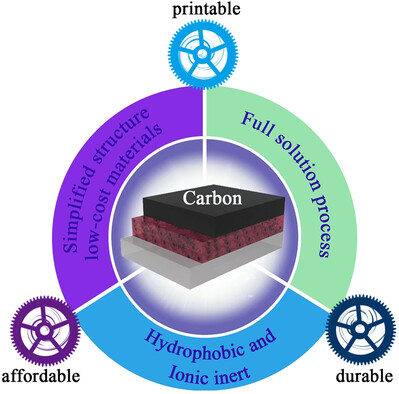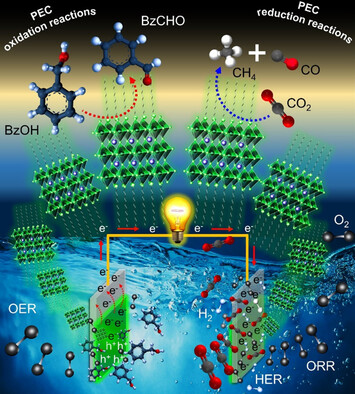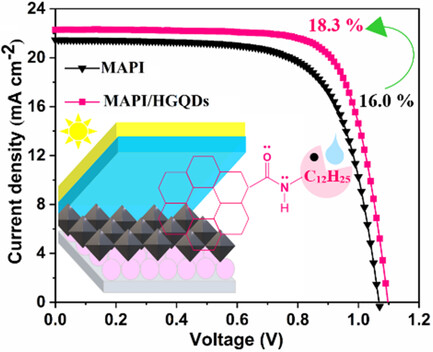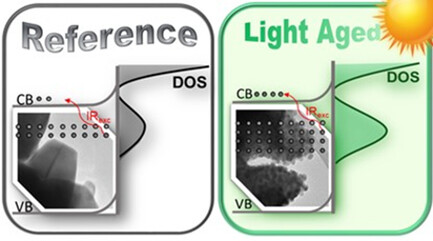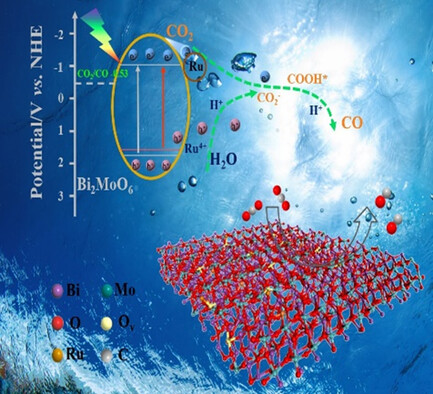Journal list menu
Export Citations
Download PDFs
Cover Picture
NH4Br-Assisted Two-Step-Processing of Guanidinium-Rich Perovskite Films for Extremely Stable Carbon-Based Perovskite Solar Cells in Ambient Air
- First Published: 11 July 2022
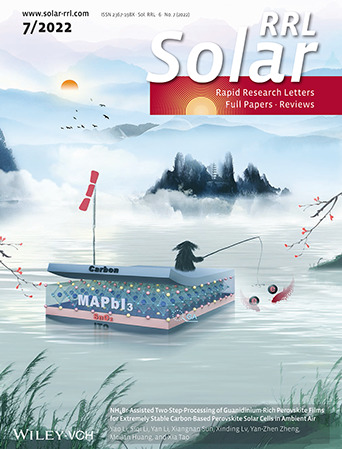
Perovskite Solar Cells
In article number 2101103, Yan-Zhen Zheng, Meilan Huang, Xia Tao, and co-workers fabricated NH4Br-assisted rich guanidinium perovskite films that allow inducing the formation of the intermediate phase NH4PbI3 and alleviating the disorder of the octahedron caused by an alien cation. The resultant films behave extremely well in photovoltaic performance upon assembly as carbon-based perovskite solar cells.
Inside Front Cover
Hydrophobic Graphene Quantum Dots for Defect Passivation and Enhanced Moisture Stability of CH3NH3PbI3 Perovskite Solar Cells
- First Published: 11 July 2022

Perovskite Solar Cells
In article number 2200023, Behzad Rezaei, Tayebeh Ameri, and co-workers applied the hydrophobic bifunctional graphene quantum dots, containing amide and alkyl chains, as an efficient interface modifier in perovskite solar cells to enhance the quality of perovskite films, passivate the defects at the surface and grain boundaries, and facilitate the hole extraction. As a result, perovskite solar cells exhibit an improved efficiency of 18.30% and keep over 80% of their initial efficiency after 960 h under ambient air.
Back Cover
Direct Observation of the Chemical Transformations in BiVO4 Photoanodes upon Prolonged Light-Aging Treatments
- First Published: 11 July 2022
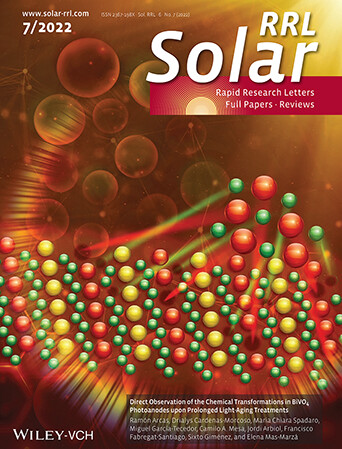
Light Aging
In article number 2200132, Camilo A. Mesa, Sixto Giménez, Elena Mas-Marzá, and co-workers demonstrated through electrochemical and microstructural analysis that oxygen vacancies correlate with a migration of Bi towards the BiVO4 surface. Light-aging has shown to increase the efficiency of BiVO4 photoanodes due to oxygen vacancies modulation but establishing chemical changes has been challenging. Highly efficient photoelectrochemical oxidation reactions are key for solar-to-fuel synthesis.
Masthead
Perspectives
Superhalogen Passivation for Efficient and Stable Perovskite Solar Cells
- First Published: 12 April 2022
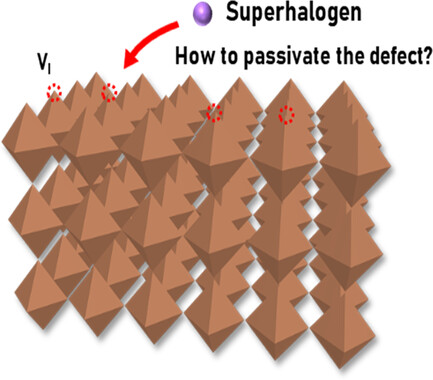
Superhalogen is a promising candidate for defect passivation and stabilization of metal-halide perovskites due to its higher electronegativity and electron affinity than halides. This perspective gives an overview of studies regarding the use of superhalogen to develop efficient and stable perovskite solar cells and concludes with an outlook of further research directions.
Carbon Electrode Endows High-Efficiency Perovskite Photovoltaics Affordable, Fully Printable, and Durable
- First Published: 01 May 2022
Reviews
Hall of Fame
Selenium: A Unique Member in the Chalcogen Family for Conjugated Materials Used in Perovskite and Organic Solar Cells
- First Published: 03 April 2022
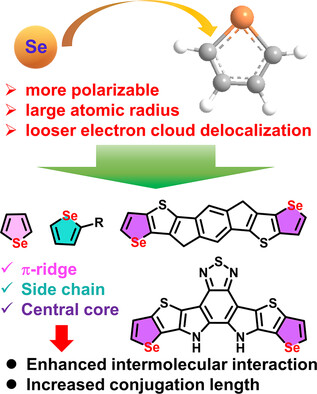
Selenium-incorporated organic conjugated materials show enhanced intermolecular interactions and reduced bandgap, which can not only improve the carrier mobility and passivate the traps on the perovskite surface for PVSCs, but also enhance the light-harvesting ability in NIR region and achieve a high Jsc for OSCs.
Application of Halide Perovskite Nanocrystals in Solar-Driven Photo(electro)Catalysis
- First Published: 15 March 2022
Hall of Fame
Ten Years of Sb2Se3 Thin Film Solar Cells
- First Published: 20 April 2022
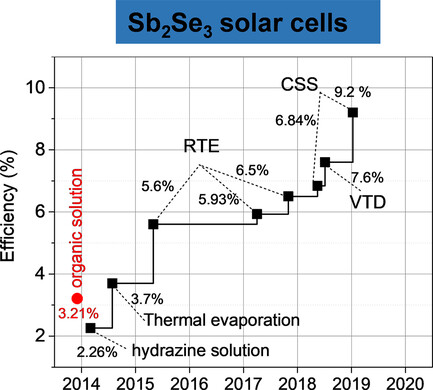
Sb2Se3 has emerged as a promising absorber material for thin film photovoltaics. This work aims to briefly present the 10 years’ development of Sb2Se3 thin film solar cells from its birth to the present, including material selection, fundamental properties, device fabrication and optimization, and potential application.
Perovskite Single-Crystal Solar Cells: Advances and Challenges
- First Published: 30 April 2022
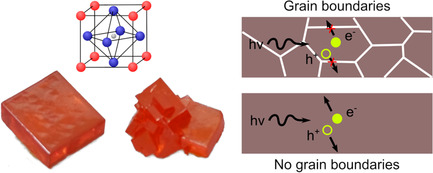
Metal-halide perovskite single crystals are a viable alternative to the polycrystalline counterpart for efficient photovoltaic devices thanks to lower trap states, higher carrier mobility, and longer diffusion length. This review provides an extensive report about the growth methods, the devices architecture and design, and the strategies used to solve the open challenges of the devices’ stability.
Phase-Pure Engineering for Efficient and Stable Formamidinium-Based Perovskite Solar Cells
- First Published: 25 February 2022
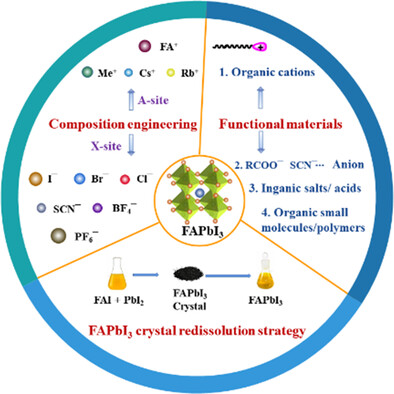
The pure-phase FAPbI3 perovskite material has not been prepared and the related properties are not deeply understood yet. This review summarizes the development and challenges of FA-based perovskite from component engineering to pure-phase perovskite technology and proposes a strategy for the development of pure-phase FAPbI3 perovskite. This helps researchers to deeply understand the properties of FA-based perovskites.
Importance and Advancement of Modification Engineering in Perovskite Solar Cells
- First Published: 26 March 2022
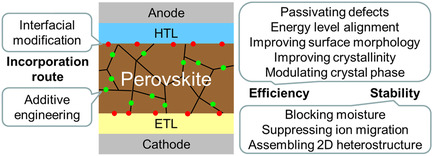
The authors made a review of the advancement of organic ionic materials which are utilized for modification engineering in perovskite solar cells. These functional materials are divided into various sections according to their roles in terms of defect passivation on the perovskite surface and grain boundary, energy level alignment, modification of surface morphology, modulation of crystal structure, stabilization of perovskite phase, suppression of ion migration and improvement of stability. The corresponding working mechanisms are thoroughly discussed. Based on the deep understanding, an outlook is proposed at the end.
In Situ Characterization for Understanding the Degradation in Perovskite Solar Cells
- First Published: 14 April 2022

In situ electron microscopy, X-Ray-assisted and optoelectronic characterization techniques as the tools presenting the dynamic degradation changes of perovskite materials and devices’ microstructure, crystal structure, chemical composition, morphology, and photoelectric properties under different stress factors are effective to reveal the degradation mechanisms of perovskite solar cell and promote their commercial application.
Research Articles
NH4Br-Assisted Two-Step-Processing of Guanidinium-Rich Perovskite Films for Extremely Stable Carbon-Based Perovskite Solar Cells in Ambient Air
- First Published: 15 March 2022
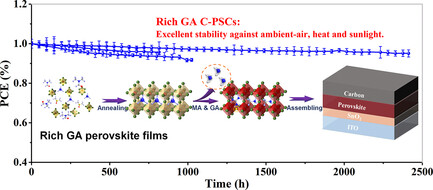
Guanidinium (GA)-rich perovskite films are prepared via an NH4Br-assisted two-step process in air conditions, in which NH4Br is introduced to facilitate the transient phase (NH4PbI3) formation and reduce voids and pinholes in films. The fabricated carbon-based perovskite solar cells (C-PSCs) in ambient air deliver the highest efficiency of 16.19% and exhibit excellent stability against moisture, heat, and sunlight.
Hydrophobic Graphene Quantum Dots for Defect Passivation and Enhanced Moisture Stability of CH3NH3PbI3 Perovskite Solar Cells
- First Published: 19 March 2022
Direct Observation of the Chemical Transformations in BiVO4 Photoanodes upon Prolonged Light-Aging Treatments
- First Published: 11 March 2022
p-Type Antimony Selenide via Lead Doping
- First Published: 09 November 2021
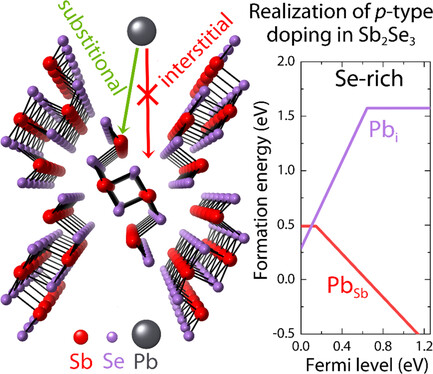
An effective p-type doping strategy in Sb2Se3 is proposed and a higher hole carrier density of 1016 cm−3 is achieved for the first time, which shows the availability to optimize the performance of Sb2Se3-based solar cells. The defect physics that is decisive for the photovoltaic properties is revealed, providing guidance for further studies on doping in Sb2Se3.
Impact of Nickel Oxide/Perovskite Interfacial Contact on the Crystallization and Photovoltaic Performance of Perovskite Solar Cells
- First Published: 23 April 2022
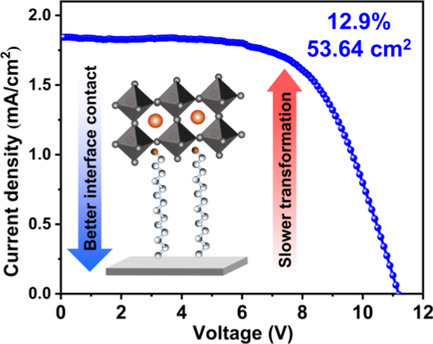
A facile route is introduced to enhance the contact of NiOX|perovskite by inserting a tetradecylamine (TeDA) interfacial layer, which modulates the wettability of NiOX film and the transformation process of wet film to perovskite. Champion efficiency of 12.9% and improved stability are achieved for the larger area (53.64 cm2) perovskite solar modules based on spray-coated NiOX.
A 3D Opened Hollow Photothermal Evaporator for Highly Efficient Solar Steam Generation
- First Published: 06 April 2022
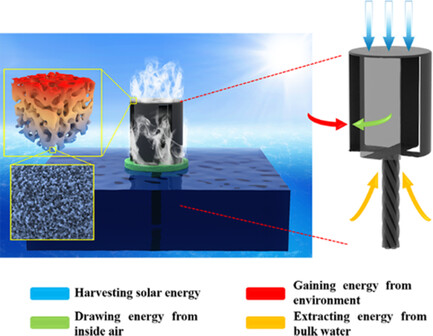
A 3D opened hollow photothermal evaporator is designed using hierarchically porous CuS–cellulose composite as photothermal materials. This special structure not only imparts the solar evaporator with efficient water evaporation by minimizing energy loss, introducing cold evaporation surfaces for harvesting additional energy from surrounding environment, but also fully activates the evaporation on inner evaporation surfaces, thus delivering extremely high evaporation rates.
Charge Separation Efficiency in WO3/BiVO4 Photoanodes with CoFe Prussian Blue Catalyst Studied by Wavelength-Dependent Intensity-Modulated Photocurrent Spectroscopy
- First Published: 15 April 2022
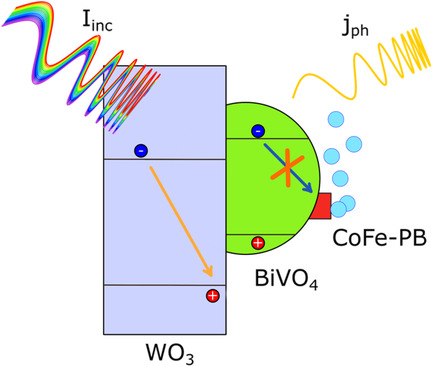
Herein, wavelength-dependent intensity-modulated photocurrent spectroscopy as a powerful tool to probe the charge carrier dynamics in complex systems is discussed. The technique is used to gain deep understanding of the loss mechanisms affecting promising materials for solar water splitting, such as WO3/BiVO4 heterojunction modified with CoFe Prussian blue catalyst, paving the way for future performance enhancement.
Chemical Solution Deposition of Single-Phase BiFeO3 Thin Films on Transparent Substrates
- First Published: 05 April 2022
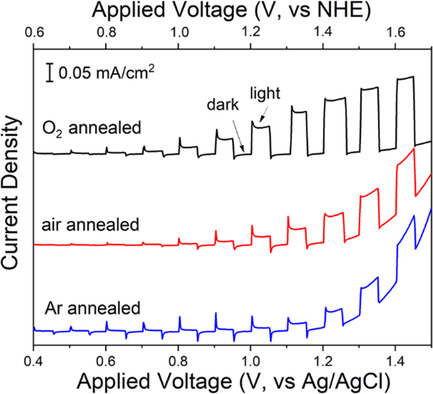
Photocurrents from nanostructured BiFeO3 films produced using low-cost chemical solution deposition indicate a photoactive material. By developing a chemical solution deposition process for BiFeO3, the production of high-quality multi-ferroic thin films for a range of applications is enabled, where a narrow bandgap photoactive material is needed. The process removes the need for an anneal in a controlled atmosphere.
Effect of Steric Hindrance of Butylammonium Iodide as Interface Modification Materials on the Performance of Perovskite Solar Cells
- First Published: 09 March 2022
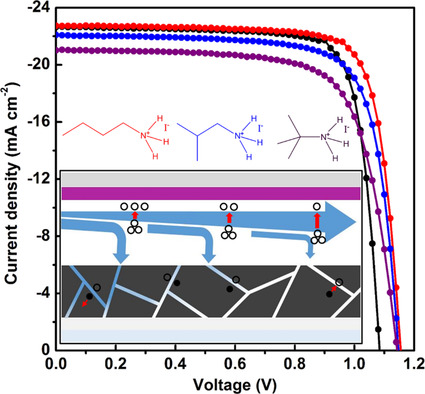
The increase in butylammonium iodide (BAI) steric hindrance weakens its diffusion to grain boundary, resulting in excessive BAI residue on the surface of perovskite films. Because diffusion to grain boundary affects the passivation of grain boundaries and excessive BAI on the surface blocks hole transport, the photovoltaic performance of the device decreases gradually with the increase in BAI steric hindrance.
3D-Printed Bionic Solar Evaporator
- First Published: 08 March 2022
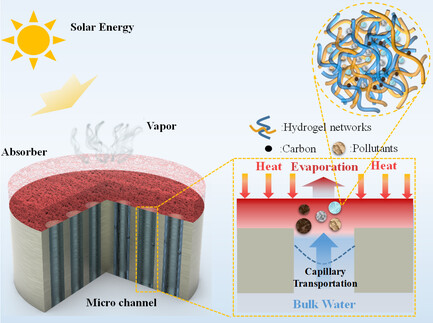
Inspired by the evaporation process of the tree in nature, the bionic solar evaporator consisting of a hydrogel solar absorber and bionic microchannels, achieves a fast water self-transport speed and a high solar water evaporation rate, which can be applied for wastewater treatment with a high purification rate up to 99.999% and a solar thermal efficiency as high as 92.1%.
Revealing the Correlation of Light Soaking Effect with Ion Migration in Perovskite Solar Cells
- First Published: 15 March 2022
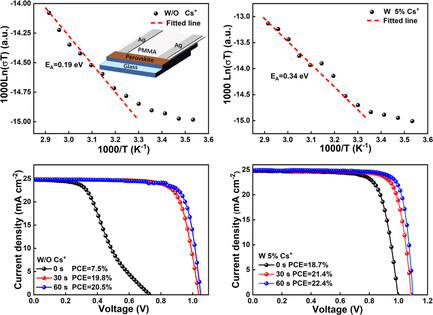
The dynamics of light soaking (LS) effect, drift-diffusion simulations, and external voltage experiments reveal the correlation of the LS effect with ion migration in perovskite solar cells (PSCs). Furthermore, the introduction of Cs+ into perovskite films reduces the density of mobile ions in PSCs, which can not only suppress the LS effect notably but also enhance the long-term stability of PSCs.
Dimensional Engineering Enables 1.31 V Open-Circuit Voltage for Efficient and Stable Wide-Bandgap Halide Perovskite Solar Cells
- First Published: 16 March 2022
Coevaporation of Doped Inorganic Carrier-Selective Layers for High-Performance Inverted Planar Perovskite Solar Cells
- First Published: 16 March 2022
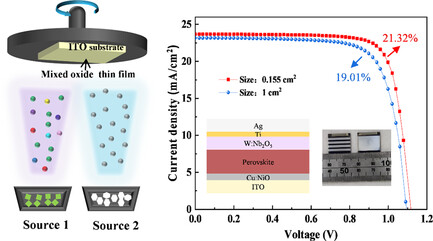
A dual-source electron beam coevaporation method is used for the controlled deposition of copper-doped nickel oxide and tungsten-doped niobium oxide as hole and electron transport layers, respectively. Perovskite solar cells based on these inorganic carrier-selective layers achieve power conversion efficiencies of 21.32% for a 0.155 cm2 device and 19.01% for a 1 cm2 device.
High-Performance Ternary Semitransparent Polymer Solar Cells with Different Bandgap Third Component as Non-Fullerene Guest Acceptor
- First Published: 15 March 2022
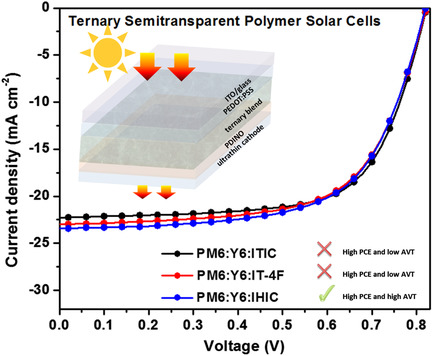
The ternary polymer solar cells demonstrate more balanced charge transport properties based on 20% third component, which improves blend film morphology and charge transport channels, where the ternary system with high average visible transmittance over 27% and power conversation efficiency over 12% is more suitable in ternary semitransparent devices than others.
A General Low-Temperature Strategy to Prepare High-Quality Metal Sulfides Charge-Transporting Layers for All-Inorganic CsPbI2Br Perovskite Solar Cells
- First Published: 16 March 2022
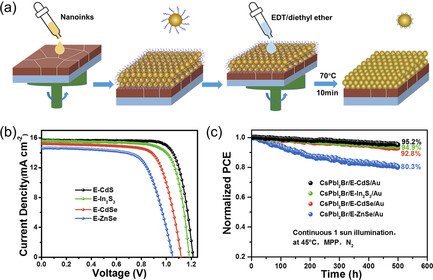
A general strategy to prepare high-quality electron transport layers (ETLs) below 70 °C by ligand exchange on top of the inorganic CsPbI2Br perovskite absorber layer is proposed. The ETLs possess smooth, dense, and pinhole-free morphologies, a suitable energy-level structure, favorable conductivity, and chemical stability, which give the whole photovoltaic devices high efficiencies and outstanding stabilities.
Characterization of the Stability of Indium Tin Oxide and Functional Layers for Semitransparent Back-Contact Applications on Cu(in,Ga)Se2 Solar Cells
- First Published: 17 February 2022
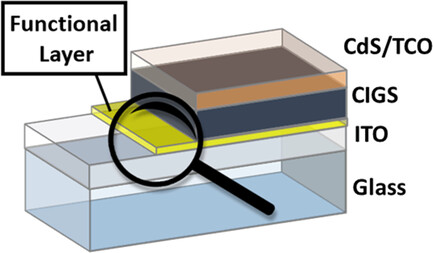
A study of the stability of ITO-based back contacts during CIGS synthesis is reported. For processing temperatures higher than 480 °C, an amorphous phase is formed at the surface of bare ITO, accompanied with degradation of transparency and device performance. Inclusion of a nanometric functional layer (and thickness optimization) allows to improve both parameters at high-temperature processing.
Extending the Absorption Limit of BiVO4 Photoanodes with Hydrogen Sulfide Treatment
- First Published: 19 March 2022
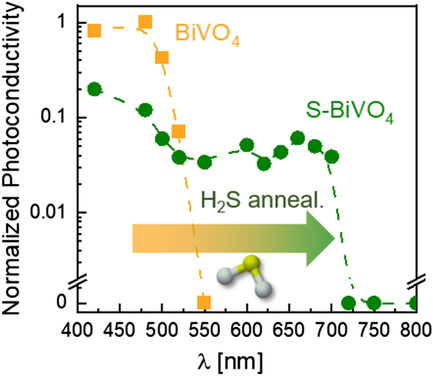
With demonstrated photocurrents approaching the theoretical limit, the photoelectrochemical (PEC) performance of BiVO4 is limited by the relatively large bandgap. Mild heat treatment under a reactive hydrogen sulfide environment enables sulfur incorporation, which reduces the bandgap and redshifts the photoconductivity onset. The modified films are unfortunately unstable during PEC measurements, but this can be solved by introducing a NiOx protection layer.
Air-Processed Carbon-Based Cs0.5FA0.5PbI3–Cs4PbI6 Heterostructure Perovskite Solar Cells with Efficiency Over 16%
- First Published: 29 March 2022
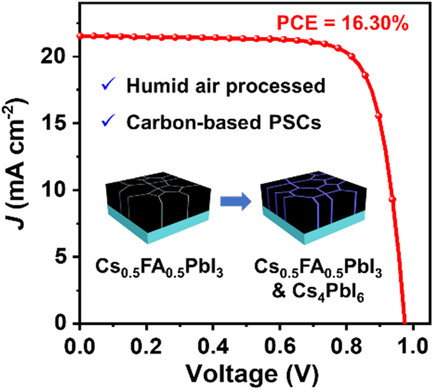
Herein, a hot-flow-assisted spin-coating method is proposed to prepare Cs0.5FA0.5PbI3 films in the humid air environment. The presence of trace amount Cs4PbI6 not only passivates the defects but also improves the stability of Cs0.5FA0.5PbI3. The carbon electrode–based perovskite solar cells (C-PSCs) with Cs0.5FA0.5PbI3–Cs4PbI6 heterostructure film show an efficiency of 16.30%, which is the highest for methylamine-free low-temperature C-PSCs.
Increased Efficiency of Organic Solar Cells by Seeded Control of the Molecular Morphology in the Active Layer
- First Published: 29 March 2022
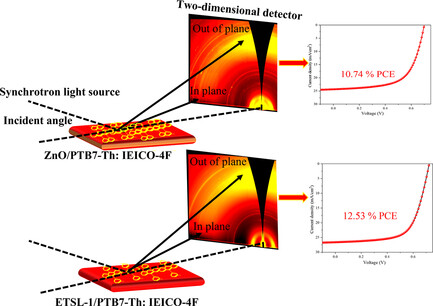
Addition of small organic molecules into the electron transport layer of inverted geometry organic solar cells is shown to seed crystallinity in the organic bulk heterojunction. Employing aromatic dicarboxylic acids on solution–gel-prepared zinc oxide electron transport layers, differing molecular morphologies of the active layer, with increased higher face-on orientations improving the power conversion efficiency, are demonstrated.
Ultrafast Random-Pyramid Texturing for Efficient Monocrystalline Silicon Solar Cells
- First Published: 23 March 2022

Herein, a way to realize 180 s of ultrafast texturing for mono-Si wafers is proposed by combining well-established metal-catalyzed chemical etching and a standard alkaline texturing process. Consequently, mono-Si passivated emitter rear contact solar cells with pyramid texture fabricated via the proposed texturing process are prepared to show an average η of 22.88% and a highest η of 23.02%.
Acid- and Base-Stable Cs2Pt(Cl,Br)6 Vacancy-Ordered Double Perovskites and Their Core–Shell Heterostructures for Solar Water Oxidation
- First Published: 26 March 2022

The most stable vacancy-ordered halide double perovskite material based on Cs2Pt(Cl,Br)6, which remains intact in harsh pH conditions and shows panchromatic visible light absorption is reported. Through an anion-exchange process, core–shell heterostructures of Cs2PtBr6/Cs2PtCl6 with type-II band alignment are obtained. These structures were employed as photoanodes without any surface protection for solar water oxidation.
Bandgap Engineering and Oxygen Vacancies of NixV2O5+x (x = 1, 2, 3) for Efficient Visible Light-Driven CO2 to CO with Nearly 100% Selectivity
- First Published: 29 March 2022
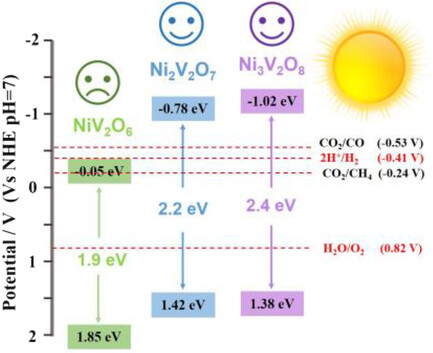
Through changing the Ni:V ratio, the band gap and band edge of nickel vanadates could be regulated, enabling Ni2V2O7 and Ni3V2O8 samples to photocatalytic CO2 to CO in the presence of water under visible-light irradiation, while NiV2O6 sample showed almost no activity. Meanwhile, the higher concentration of oxygen vacancies over Ni2V2O7 sample further enhanced the photocatalytic activity for CO2 conversion into CO.
Experimental Characterization and Statistical Analysis of Water-Based Gold Nanofluids for Solar Applications: Optical Properties and Photothermal Conversion Efficiency
- First Published: 26 March 2022

In this article, the use of water-based gold nanofluids is proved to enhance the photothermal conversion efficiency (PTE) of direct solar absorption collectors. Nanofluids (NFs) are colloidally stable and an increase in PTE of up to 121% with respect to water is achieved. Statistical analysis confirms the influence of nanoparticle (NP) size and concentration on the conversion efficiency.
Green-Solvent-Processed 17% Efficient Polymer Solar Cell Achieved Synergistically by Aligning Energy Levels and Improving Morphology with the Quaternary Strategy
- First Published: 26 March 2022
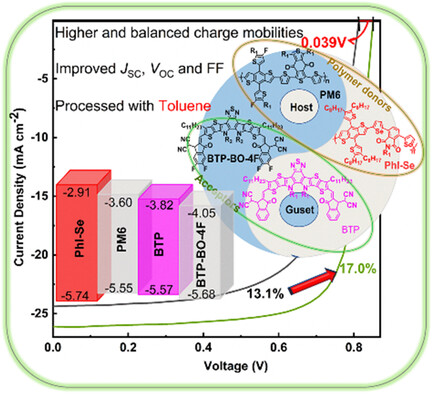
An energy-level-aligning quaternary material system is reported with an ultra-wide bandgap and deep-highest occupied molecular orbital (HOMO) level polymer donor (PhI-Se) and an upshifted-HOMO nonfullerene acceptor (BTP) as the guests. The addition of PhI-Se and BTP greatly improves the toluene-processed active layer film quality and solar cell performance, yielding 17% efficiency. The host binary device only shows 13.1% efficiency when processed with toluene.
Ionic Liquid-Tuned Crystallization for Stable and Efficient Perovskite Solar Cells
- First Published: 26 March 2022
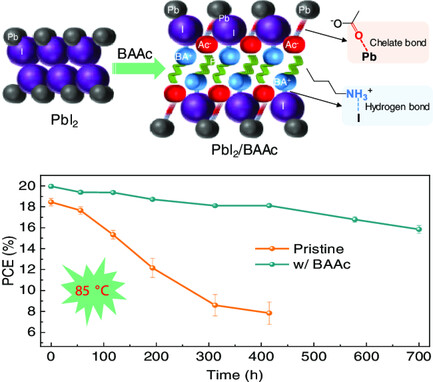
An ionic liquid butylammonium acetate (BAAc) is introduced to PbI2 to tune the crystallization of perovskites to improve device stability. The BAAc-treated devices show better thermal stability with maintaining 79.5% of initial efficiency after 700 h of aging at 85 °C in nitrogen environment, as compared to the pristine device that retained 47.2% of its initial efficiency after 312 h.
Formation of Native Inx(O,S)y Buffer through Surface Oxidation of Cu(In,Ga)(S,Se)2 Absorber for Significantly Enhanced Conversion Efficiency of Flexible and Cd-Free Solar Cell by All-Dry Process
- First Published: 26 March 2022
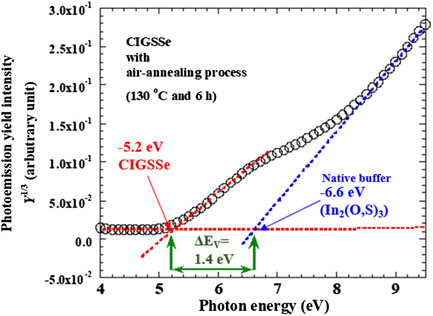
Native Inx(O,S)y buffer near Cu(In,Ga)(S,Se)2 (CIGSSe) surface formed after air-annealing process gives rise to self-forming heterojunction, acting as charge separation and hole-blocking barrier with different valence band offset (ΔEV) of native Inx(O,S)y/CIGSSe to 1.4 eV. Herein, efficiency of 16.7% for flexible, Cd-free, and all-dry process CIGSSe solar cell on SUS substrate is ultimately attained with potential toward Lab-to-Fab transition.
Hysteresis-Free Planar Perovskite Solar Module with 19.1% Efficiency by Interfacial Defects Passivation
- First Published: 30 March 2022
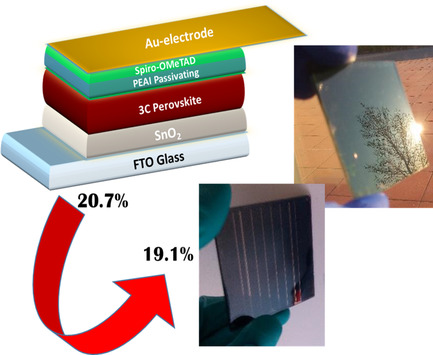
Herein, an efficiency of 19.1% with near-zero hysteresis for a low-temperature planar n–i–p perovskite module (11 cm2 aperture area, 91% aspect ratio) by avoiding dimethyl sulfoxide detrimental effect, by phenethylammonium iodide defect passivation and by optimized interconnections engineering is demonstrated. The scaling-up loss from cell to module is about 8%, showing homogeneous and defect-free layers, and high reproducibility.
Effect of Zn(S,O,OH) Buffer Thin Films Formed on CIGS through Different Stages and Reaction Processes in Chemical Bath Deposition: Interpretations from Mechanisms and Transformation Kinetics Perspective
- First Published: 30 March 2022

This is a schematic diagram of the Zn buffer thin film formation process with different properties due to anion shape and pH. The interface between Cu(In,Ga)Se2 (CIGS) and these Zn buffer thin films has different band structures, showing different performance of solar cells. These results are interpreted using the mechanism and transformation kinetics, and these interpretations are verified through analysis.
Formation of Metal Cation/Oxidized Pyridine Complexes-Based Bifunctional Interfacial Layer for Fabrication of Highly Efficient and Reproducible Perovskite Solar Cells
- First Published: 01 April 2022
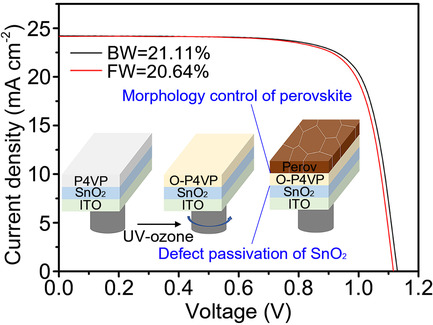
Oxidized poly(4-vinylpyridine) (O-P4VP) as an interfacial passivation layer of perovskite solar cells improves power conversion efficiencies to 21.11% and environmental stability. Based on metal–pyridine complexation, defect passivation of SnO2 and increase in the grain size of perovskite are achieved simultaneously. The insoluble passivation layer in perovskite solutions also contributes to the fabrication of highly reproducible devices.
Ni Foam Supported TiO2 Nanorod Arrays with CdS Branches: Type II and Z-Scheme Mechanisms Coexisted Monolithic Catalyst Film for Improved Photocatalytic H2 Production
- First Published: 29 March 2022
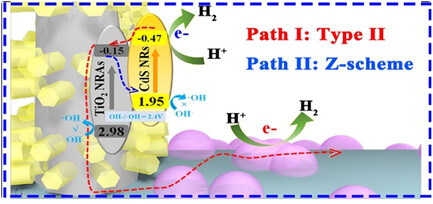
Both type II and Z-scheme charge transport mechanisms coexist in the novel Ni foam supported TiO2@CdS thin-film photoelectrode, and an enhanced Z-scheme charge transfer effect accelerates the photogenerated charge separation and transport efficiency for photocatalytic (PC) and photoelectrochemical (PEC) hydrogen production.
Toward Understanding the Short-Circuit Current Loss in Perovskite Solar Cells with 2D Passivation Layers
- First Published: 29 March 2022
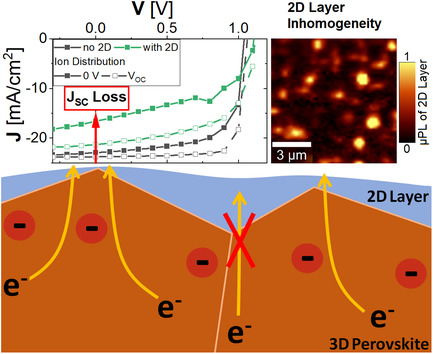
Herein, the mechanism behind the short-circuit current loss observed upon introducing a 2D passivation layer in p–i–n perovskite solar cells is elucidated. Based on experiments and drift–diffusion simulations, the loss is linked to the inhomogeneity of the 2D passivation layer and the ionic space charge, which reduces the effective charge-carrier diffusion length.
Slow Hole Transfer Kinetics Lead to High Blend Photoluminescence of Unfused A–D–A′–D–A-Type Acceptors with Unfavorable Highest Occupied Molecular Orbitals Offset
- First Published: 05 April 2022
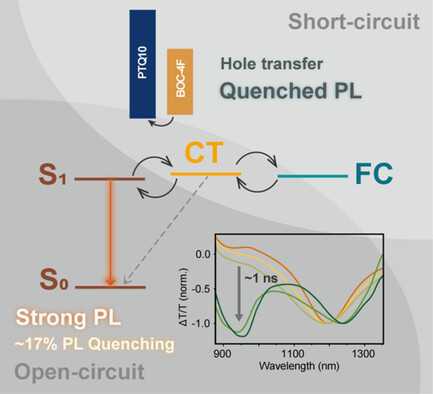
The model system PTQ10:BOC-4F with high blend photoluminescence and negative offset is found to have a well-established equilibrium between singlet excitons, charge transfer states, and free charges. The discrepancy between high charge generation efficiency and low photoluminescence quenching is due to the shift of the equilibrium and slow hole transfer under short circuit and open circuit.
ITO-Free Indoor OPV Modules from Nonhalogenated Solvents
- First Published: 01 April 2022
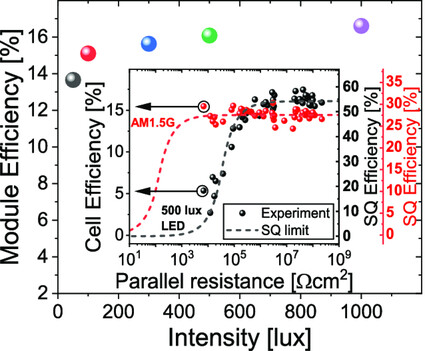
Energy harvesting by indoor photovoltaics is a very promising candidate to supply the energy for the demand of billions of internet-of-things devices. The indium-tin-oxide-free organic photovoltaic modules presented herein show great potential to fulfill these needs. Their large parallel resistance enables use cases at ultralow intensities of 50 lux, which is exceptional in this field.
Improvement in the Performance of Inverted 3D/2D Perovskite Solar Cells by Ambient Exposure
- First Published: 03 April 2022

Phenylethylammonium iodide (PEAI) treatment results in the formation of 2D PEA2PbI4 capping layer on 3D perovskite which passivates defects and increases hydrophobicity, but hinders electron collection. The ambient exposure downshifts energy levels facilitating charge collection, improving efficiency and stability. Energy-level alignment with PEAI treatment is also affected by hole transport layer (HTL)/perovskite interface modification, which facilitates favorable alignment with PEA2PbI4.
Effective Surface Passivation via Intermolecular Interactions for High-Performance Perovskite Solar Cells
- First Published: 05 April 2022

Featuring two hydroxyls and one carbonyl, 1,3-dihydroxypropan-2-one is introduced to passivate the uncoordinated lead cations and organic components on the surface of perovskite films via coordination and hydrogen bonding interactions. The device efficiency is improved from 20.21% to 23.26%, as well as better storage and thermal stability.
Highly Selective Photocatalytic Reduction of CO2 to CO Over Ru-Modified Bi2MoO6
- First Published: 05 April 2022
High-Efficiency P3HT-Based All-Polymer Solar Cells with a Thermodynamically Miscible Polymer Acceptor
- First Published: 06 April 2022
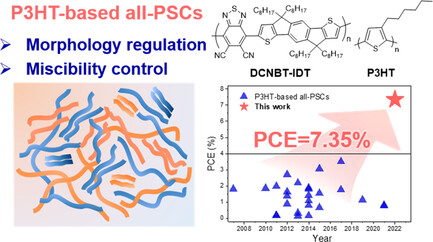
Herein, a poly(3-hexylthiophene) (P3HT)-based all-polymer solar cell (all-PSC) with a record efficiency of 7.35% is achieved by blending P3HT with a thermodynamically miscible polymer acceptor DCNBT-IDT. Morphology characterization and the Flory–Huggins model unravel that the formation of well-mixed morphology with fibrillary structures due to the appropriate miscibillity between P3HT and DCNBT-IDT is the key to the unprecedented efficiency.
Building Bulk Heterojunction to Enhance Hole Extraction for High-Performance Printable Carbon-Based Perovskite Solar Cells
- First Published: 13 April 2022
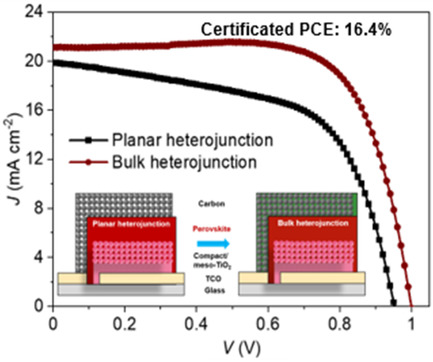
A two-step orthogonal solvent method that enables straightforward fabrication of multilayer perovskite films is applied to construct the perovskite/carbon heterojunction for carbon-based perovskite solar cells (PSCs). Such a bulk heterojunction (BHJ) improves the interface contact and facilitates the hole transport between perovskite and the carbon electrode, significantly boosting the power conversion efficiency (PCE) to 16.4% with certification.
Guanidine Thiocyanate-Induced High-Quality Perovskite Film for Efficient Tin-Based Perovskite Solar Cells
- First Published: 20 April 2022
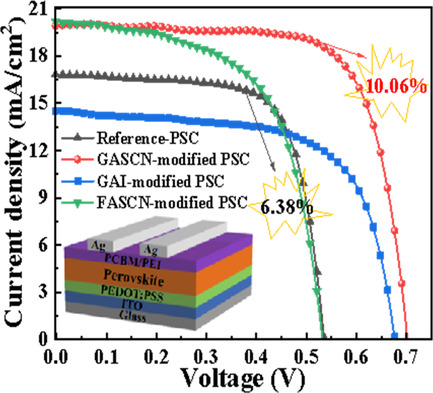
Guanidine thiocyanate (GASCN) is selected to regulate quality of PEA0.1FA0.9SnI3-based perovskite film. The GASCN additive can form Lewis adducts with uncoordinated Sn atoms, inhibit the oxidation of Sn2+, and passivate the trap states. Thus, the unsealed tin-based perovskite solar cells with GASCN additive at the optimal process demonstrate a champion efficiency of 10.06% with better stability.
Efficient Flexible Perovskite Solar Cells with Reduced Hysteresis Employing Cobalt Nitrate Treated SnO2
- First Published: 15 April 2022
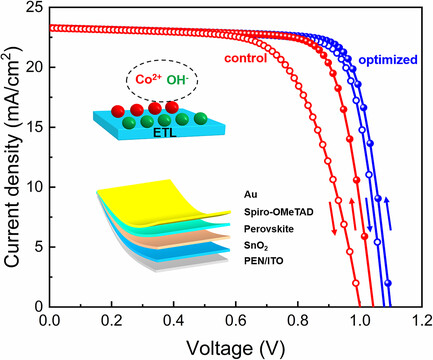
Cobalt modulation of SnO2 electron transporting layer (ETL) significantly improves the performance and reduces the hysteresis of flexible perovskite solar cells (PSCs). Cobalt nitrate improves the crystallinity of SnO2 nanoparticles, reduces surface defects of ETL and facilitates perovskite film growth, leads to hysteresis-less flexible PSCs with efficiencies over 20% in regular structure.
Realizing High-Efficiency Perovskite Solar Cells by Passivating Triple-Cation Perovskite Films
- First Published: 20 April 2022
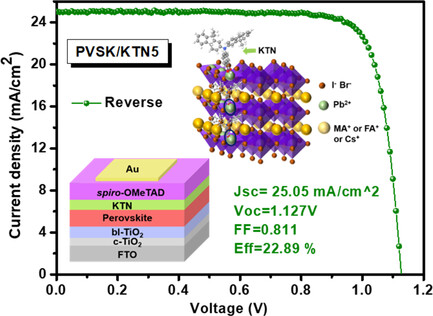
The strong interaction between 4-(bis(9,9-dimethyl-9 H-flouren-2-yl)amino)-1-naphthoic acid (KTN) and iodide vacancies exposing Pb2+ reduces the nonradiative recombination and elongates the carrier lifetime, leading to an outstanding PCE approaching 23% with a notable increase in open-circuit voltage (VOC) of 60 mV.
Realization of High-Voltage Output on Monolithic Silicon Solar Cells in Series for Self-Powered Systems
- First Published: 20 April 2022
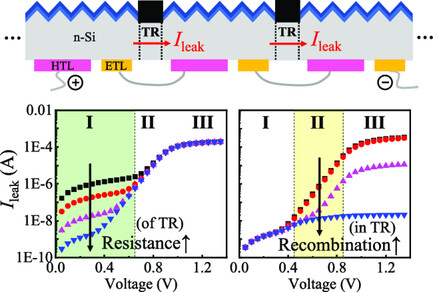
Herein, a series-interconnected monolithic on-chip solar micromodules, with the capability to output high voltage by controlling the number of sub-cells, is proposed. An in-depth analysis of an unconventional non-shunt resistance type of leakage mechanism under injection are performed based on numerical simulation. Simulation reveals that high efficiency (≥24.0%) can be achieved by several unusual strategies to suppress leakage current.
Amino Acid-Based Low-Dimensional Management for Enhanced Perovskite Solar Cells
- First Published: 23 April 2022
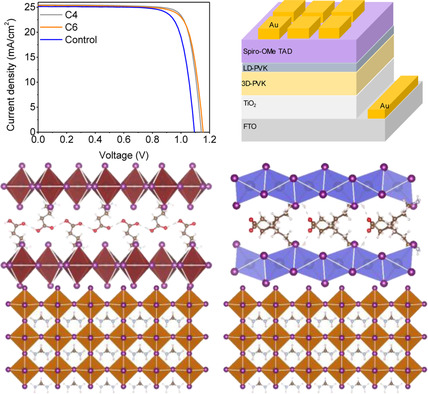
The devices with 4-aminobutyric acid and 6-aminocaproic acid iodides forming 2D and 1D capping layers on the 3D films achieve high efficiencies of 23.48% and 23.11%, respectively, and show stable stability maintaining 93.73% and 91.58% of their initial efficiencies, respectively, after 2000 h exposure in atmosphere. 2D capping is more suitable for enhancing 3D perovskite performance than the 1D capping.
Scaling Considerations for Organic Photovoltaics for Indoor Applications
- First Published: 14 April 2022
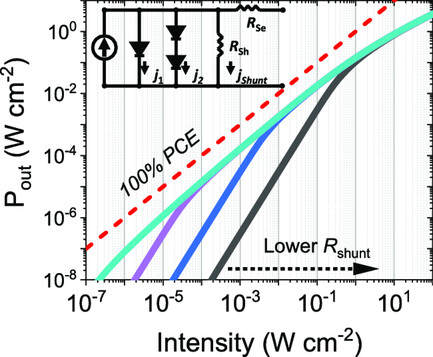
Owing to properties such as tailorable light absorption, solution processability, and low material toxicity, organic photovoltaic (OPV) devices are particularly suited to indoor light-harvesting applications. Such devices may be used incorporated into sensor devices for “Internet-of-Things” (IoT) applications. Herein, the implications for the fabrication of large-area devices and the requirements for large shunt resistances for low-light performance are examined.
Enhancement of Hole Extraction Efficiency of Dibenzothiophenes by Substitution Engineering: Toward Additive-Free Perovskite Solar Cells with Power Conversion Efficiency Exceeding 20%
- First Published: 20 April 2022
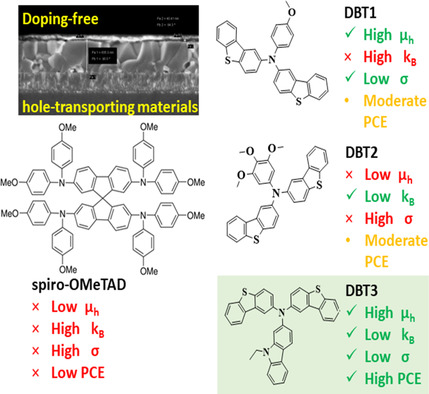
Dopant free hole transporting materials i.e., derivatives of dibenzothiophene and carbazole used in perovskite solar cells reaching power conversion efficiency of 20.90% which correlate with effects of 1) the hole transport, 2) the efficiency of the hole transfer from the perovskite phase to hole transporters, and 3) the charge collection at an electrode.
Scalable Growth of Stable Wide-Bandgap Perovskite towards Large-Scale Tandem Photovoltaics
- First Published: 20 April 2022
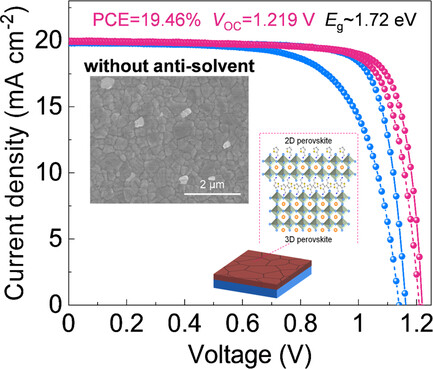
With NMP solvent-induced lead halide-templated growth, large-area high-quality wide-bandgap perovskite films with suppressed photoinduced phase segregation are easily prepared without the use of antisolvent, achieving a champion power conversion efficiency of 19.46% with VOC of 1.219 V, after further post-treatment of 2-ThMABr. These strategies show promise in the fabrication of large-scale perovskite solar modules and tandem devices.





